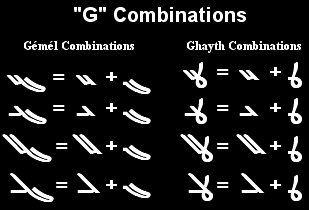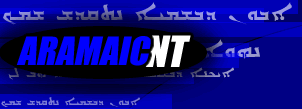|
The most important part of any written language is, you guessed it, the
alphabet. A series of symbols or glyphs designed to represent the spectrum
of sounds speakers make. Throughout the world, there are hundreds of different
alphabets and writing systems. Aramaic happens to stem from one of the
oldest, the old Phonecian (the same that Greek came from) and Aramaic
has been written dowm for approximately the last 3000 years. Needless
to say, it has shifted forms many times throughout it's life, and still
thrives today!
In Aramaic, the alphabet is called the "alépbeet" based
off of it's first two letters ܐ (alép) and ܒ
(beet). Now with those two introductions, here's the rest of the
family in their traditional order:
ܐ ܒ ܓ ܕ ܗ ܘ ܙ
ܚ ܛ ܝ ܟ ܠ ܡ ܢ ܣ ܥ
ܦ ܨ ܩ ܪ ܫ ܬ
And now here they are with a bit more information about them.
First, a blown up version of the letter,
Followed by a romanization and it's name spelled out in Aramaic,
Followed by it's pronounciation,
Followed by how it is represented in my romanizations.
|
ܐ
"Alép"
(ܐܳܠܰܦ)
Pronounciation:
Silent!
Romanization:
_ (underlined)
|
ܠ
"Léméd"
(ܠܰܡܰܕ)
Pronounciation:
"L" as in "Live"
Romanization:
"L"
|
|
ܒ
"Beet"
(ܒܺܝܬ)
Pronounciation:
"B" as in "Boy"
Romanization:
"B"
|
ܡ
"Meem"
(ܡܺܝܡ)
Pronounciation:
"M" as in "Mother"
Romanization:
"M"
|
|
ܓ
"Gamél"
(ܓܐܡܰܠ)
Pronounciation:
"G" as in "Girl"
Romanization:
"G"
|
ܢ
"Noon"
(ܢܽܘܢ)
Pronounciation:
"N" as in "Noon"
Romanization:
"N"
|
|
ܕ
"Dalat"
(ܕܳܠܳܬ)
Pronounciation:
"D" as in "Dog"
Romanization:
"D"
|
ܣ
"Simkath"
(ܣܺܡܟܳܬ݂)
Pronounciation:
"S" as in "Slip"
Romanization:
"S"
|
|
ܗ
"He"
(ܗܶܐ)
Pronounciation:
"H" as in "Hot"
Romanization:
"H"
|
ܥ
"'e"
(ܥܶܐ)
Pronounciation:
A very soft, sharp "uh" at the back of the throat.
Romanization:
" ' "
|
|
ܘ
"Waw"
(ܘܳܐܽ)
Pronounciation:
"W" as in "Wish"
Romanization:
"W"
|
ܦ
"Pe"
(ܦܶܐ)
Pronounciation:
"P" as in "Fish"
Romanization:
"F"
|
|
ܙ
"Zayn"
(ܙܳܝܢ)
Pronounciation:
"Z" as in "Zebra"
Romanization:
"Z"
|
ܨ
"Tsade"
(ܨܳܕܶܐ)
Pronounciation:
A "TS" as at the end of "Quince"
Romanization:
"TS"
|
|
ܚ
"Kheyt"
(ܚܶܝܬ)
Pronounciation:
A hard "CH" as in "Bach"
Romanization:
"KH"
|
ܩ
"Qoop"
(ܩܽܘܦ)
Pronounciation:
A "G" at the back of the throat. Use your epiglottis!
:-)
Romanization:
"Q"
|
|
ܛ
"Ghayth"
(ܛܳܝܬ݂)
Pronounciation:
Like a sounded Kheyt (sounded as in the difference between "S"
and "Z" or "P" and "B").
Romanization:
"GH"
|
ܪ
"Resh"
(ܪܶܫ)
Pronounciation:
"R" as in "Rip"
Romanization:
"R"
|
|
ܝ
"Yood"
(ܝܽܘܕ)
Pronounciation:
"Y" as in "Yes"
Romanization:
"Y"
|
ܫ
"Shin"
(ܫܺܝܢ)
Pronounciation:
"SH" as in "Shower"
Romanization:
"SH"
|
|
ܟ
"Kap"
(ܟܳܦ)
Pronounciation:
"K" as in "Kick"
Romanization:
"K"
|
ܬ
"Taw"
(ܬܳܘ)
Pronounciation:
"T" as in "Top"
Romanization:
"T"
|
These basic consonants make up all of the words of the Aramaic language,
but, as I stated earlier, there are MANY versions of this alépbeet.
Check out the chart below to see which set your computer's Unicode font
displays in.
NOTICE!
FOR NOW I HIGHLY RECOMMEND THAT YOU ONLY LEARN THE ALÉPBEET
THAT YOUR COMPUTER DISPLAYS IN
Although I do list other alŽpbits here, the lessons will mainly
be using the alépbeet that your computer displays as
a default, and Estrangela. (Since most computers display Estrangela
by default this should be no problem). After you're more familliar
with the language I would recommend you learning about the other
writing systems.
I warn about this only because trying to learn 5 different
alépbeets for the same language at once will only
result in a headache.
|
Estrangela / Estrangelo:

|
The most well-known Aramaic script is Estrangela.
This is what the most ancient Aramaic documents containing the
New Testament were written in, and it is the basis for what all
modern Aramaic alapbets are derived from. In Estrangela, there
are three types of letters, which I have seperated out using three
rows. In the first row, we have our normal letters. These can
be used at the beginning of words, and in the middle of words
(intermedial).
At the end of words, however, some letters (kap,
mim, nin, and simkath) have what are called "final forms."
Much like modern Hebrew, these letters are written differently
if found at the end of a word.
Kap and Nun even have another form called an "unattached"
form. When they are written on their own as a single letter, or
if they're found at the end of a word after a letter that does
not have a line after it to attach to other letters (like a Waw)
they are written as shown in row three.
|
Estrangela Letter Combinations:

|
In Aramaic script, certain letters look differently
when they are combined. There are only two such combinations in
Estrangela: (from right to left)
Taw-Léméd
When a LŽmŽd preceeds a final AlŽp, it takes on this form,
where the two letters crisscross.
Taw-Alép
When a Taw preceeds a final AlŽp, it takes on this form, the second
leg of the AlŽp absorbed into the Taw, and the two stems crisscrossing.
|
Eastern:
(aka Swadaya, Neostorian, Assyrian, etc.)

|
The closest of the other scripts to Estrangela
is the Eastern script family. It is written identically to Estrangela,
only the letters are drawn a bit differently (the most notable
of these being Alep, Dalat, He, Waw, Mim, Rish, and Taw), and
AlŽp now has a final form.
In Eastern script, Estrangela characters are used
for titles, names, and headlines.
Eastern is also the most likely script that your
computer will display in Unicode.
|
Eastern Letter Combinations:

|
Eastern script, like Estrangela, has combinations
as well, only there are four of them (three groups). Going from
right to left:
Resh-Final AlŽp and Dalat-Final AlŽp
When a Resh or a Dalat preceeds a Final AlŽp, the AlŽp is "demoted"
to a normal AlŽp.
LŽmŽd-AlŽp
When a LŽmŽd preceeds a final AlŽp it takes on this form.
Taw-AlŽp
When a Taw preceeds a final alŽp, it takes on this form. The
form on the left is the old "traditional style" (note
how it looks more closely to the Estrangela Taw-AlŽp) while the
form on the right is the modern script.
|
Western:
(aka Serto, Jacobite, Maronite etc.)

|
This script happens to be my favorite out of all
of the scripts I know, but it is the most confusing for someone
new to the language. This evolved from Estrangela during the Westward
spread of Christianity. It is the most "cursive" script
of all Aramaic scripts, and has a look that's pleasing to the
eye. Ironically, one form of this script is named "Serto,"
which quite litterally means "scratch." Funny how "scratch"
is, in my opinion, the most beautiful of the scripts.
Since it is very flowing and suited for writing
with a pen, each letter has two forms (two different ways to be
written) but three uses: Initial, Intermedial, and Final. As described
above:
When a letter is written at the beginning of a
word (Initial), it is always written as shown in the first row.
When a letter is written in the middle of a word
(Intermedial)), it is always written as the character right above
the line; and,
When a letter is written at the end of a word
(Final), it is always written as shown in the second row, otherwise
(if there is no letter in row two) as in row 1.
For example, if a Waw is written the same way
no matter where it is, but an Alep is only written as a squiggly
line at the beginning of words.
|
Western Letter Combinations:
AlŽp-LŽmŽd Combinations

|
Since Serta (the Western AlŽpbeet) is designed
to be a flowing, written script ("cursive" as you might
say) there are several combinations. The first two have to do
strictly with the letters AlŽp and LŽmŽd.
AlŽp-LŽmŽd
This combination is only used at the beginning of words, the
AlŽp written on the slant of the LŽmŽd.
LŽmŽd-AlŽp
The exact opposite of the previous example. It can be utilized
anywhere in a word. For example, the Aramaic word for "no"
(La) is this combination by itself.
|

|
Now come the combinations that make more sense.
The "G" (GŽmŽl and Ghayth) Combinations.
Although the chart above may look menacing, all
you need to do is remember one thing:
When a LŽmŽd or 'E follows a "G"
character, it's stem is an extention of the ending upwards stroke.
This can occur anywhere in a word, so I have left
examples of both final and medial characters.
|
Hebrew Blockletters:

|
This should be a very familliar script to anyone
who knows modern Hebrew, or is a student of Old Testament studies.
Aramaic was written in this script for many hundreds of years
in many different places.
The Aramaic in the Old Testament is preserved
to this day in Hebrew Blockletters.
Hebrew Blockletters only have 5 Final forms, written
as shown in row 2 only at the end of words.
Although the writing logistics are much simpler,
the largest problem with Hebrew is that many letters look so much
alike, making it difficult to read at a distance. For example,
on signs in Israel, the scripts must exaggerate the baseline of
a Beth (Bit), so that it does not look like a Kap. The same goes
for the toplines of Dalet (Dalat) and Resh (Rish).
If you haven't already guessed, the letters, themselves,
have different names than their Aramaic counterparts, usually
the only variance being vowels.
|
Ancient Aramaic:

|
The oldest Semetic alapbet, Ancient Aramaic is
what Hebrew and Estrangela came from. This script is what the
Old Testament was originally written in, without vowels or dialect
marks. When God wrote on the wall, this is what it was in, and
His Name was revealed in these characters.
Since some of the letters look VERY much alike
(ie, it is very difficult to tell apart a Dalat from a Rish, except
for the slight bend on the "stem"), this alapbet dropped
out of use millenia ago, but we still have many inscriptions that
have been unearthed that survive to this day.
|
Well that's the Alapbet in a nutshell.
On to Lesson 2: Vowels! :-)
|

